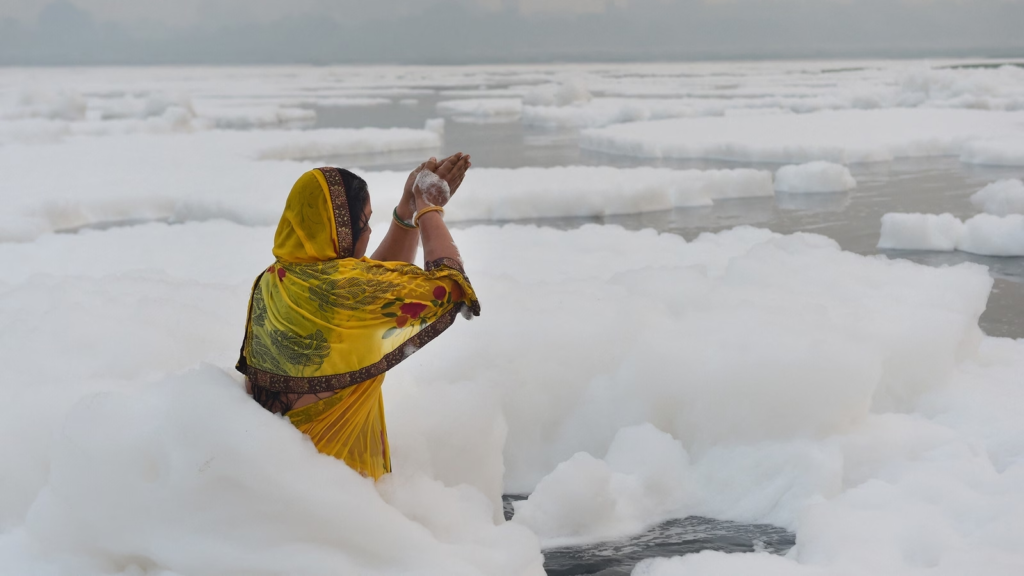Toxic Foam Covers Yamuna River as Pollution Level Surges in Delhi. The Yamuna River, revered as one of the holiest rivers in India, faces a dire environmental crisis that threatens both its sacred status and the health of millions.
In New Delhi, the river is blanketed with toxic foam, a consequence of relentless pollution from industrial activities, inadequate waste management, and seasonal agricultural practices.
As the pollution crisis escalates, the implications for public health, environmental sustainability, and cultural practices become increasingly alarming.
Foam Covers Yamuna
Flowing over 1,376 kilometers, the Yamuna is not only a vital water source for New Delhi but also holds immense spiritual significance for Hindus. Millions of devotees flock to its banks for ritualistic bathing, believing that immersion in its waters purifies the soul and washes away sins. However, this deep-seated belief is now being tested by the visible degradation of the river’s health.
Read : Delhi Becomes World’s Most Polluted City
Residents like Jasraj, a 70-year-old retiree, reflect the conflicting sentiments surrounding the Yamuna. Having participated in bathing rituals since 1980, Jasraj asserts that despite the foam and pollution, he continues to worship the river as a mother figure. “It’s dirty on the surface but clean below the top,” he remarks, encapsulating the traditional perspective that often downplays the visible signs of contamination.
Read : Environmental Alarms: Uncovering the Top 10 Most Polluted Nations
Yet, this faith in the river’s sanctity does not mitigate the stark reality that millions are exposed to harmful pollutants. The foam, formed primarily from industrial effluents, sewage, and agricultural runoff, poses significant health risks. With the upcoming Chhath Puja festival, when thousands will gather to immerse themselves in the toxic waters, the potential for health crises looms large.
The Pollution Crisis: Causes and Consequences
The Yamuna’s transformation into one of the most polluted rivers globally is not a recent phenomenon but rather a result of decades of neglect and mismanagement. Industrial pollutants, untreated sewage, and agricultural pesticides relentlessly flow into the river, exacerbating its contamination. Despite numerous regulations aimed at preserving its sanctity, enforcement remains lax, allowing industries to operate with minimal accountability.
The current situation is further compounded by seasonal factors. During festivals like Chhath Puja, pollution levels are expected to spike as crowds gather at the riverbank, increasing the risk of waterborne diseases.
The authorities’ attempts to mitigate the situation—such as deploying motorboats to disperse foam and using defoamers—have proven inadequate. Furthermore, bamboo barricades erected to keep devotees away from the banks serve as a temporary measure rather than a long-term solution.

As pollution levels soar, the health implications become critical. The toxic foam, primarily composed of surfactants and chemicals, can cause skin irritations, respiratory problems, and other health issues among those who come into contact with it. The lack of clean drinking water further complicates matters, as many rely on the Yamuna as their primary source.
Air Quality Crisis: A Broader Environmental Concern
The pollution crisis surrounding the Yamuna is part of a larger environmental catastrophe facing New Delhi. Known for having some of the most polluted air in the world, the city grapples with deteriorating air quality exacerbated by seasonal factors and human activities. The air-quality index (AQI) recently reached ‘very poor’ levels, driven by emissions from firecrackers, vehicular pollution, and crop burning in neighboring agricultural regions.
With winter approaching, the situation is predicted to worsen. During this season, the city’s topography traps pollutants, creating a toxic haze that obscures the sky and poses severe health risks to its residents.
The tiny PM 2.5 particulate matter, which can penetrate deep into the lungs, contributes to a rise in respiratory ailments, making the struggle for cleaner air a pressing public health issue.
Authorities have responded by implementing temporary measures, such as restricting construction activities, regulating vehicle emissions, and deploying anti-smog guns. However, these efforts often fall short of addressing the root causes of pollution.
India’s Supreme Court has criticized regional governments for their failure to enforce stricter regulations, particularly regarding crop burning, which significantly contributes to air quality deterioration.
As millions of people in New Delhi navigate the challenges posed by air pollution, the intersection of environmental degradation and public health remains a critical concern.

The plight of the Yamuna River reflects a broader narrative about the urgent need for sustainable practices, effective governance, and community awareness to combat pollution and safeguard both the environment and public health.
The Yamuna River, once a revered symbol of purity and spirituality, is now emblematic of the environmental crises facing urban India. The toxic foam covering its surface serves as a stark reminder of the consequences of industrial pollution, inadequate waste management, and cultural practices that clash with ecological realities.
As millions prepare for rituals along its banks, the need for urgent action to restore the river’s health and protect public safety has never been more pressing.
The challenges presented by pollution extend beyond the Yamuna, encompassing the air quality crisis that grips New Delhi each winter. To address these intertwined issues, a multifaceted approach involving stricter regulations, community engagement, and sustainable practices is essential.
Only through collective action can the sacred Yamuna be revitalized and the health of millions safeguarded for generations to come.
let’s enjoy few years on earth with peace and happiness….✍🏼🙏

